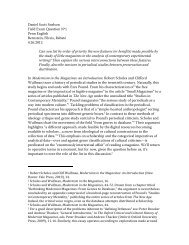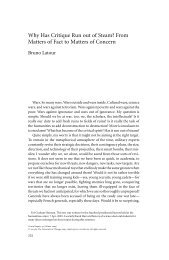The Exploit: A Theory of Networks - asounder
The Exploit: A Theory of Networks - asounder
The Exploit: A Theory of Networks - asounder
Create successful ePaper yourself
Turn your PDF publications into a flip-book with our unique Google optimized e-Paper software.
Coda 155<br />
<strong>The</strong> point here is not that networks are inherently revolutionary<br />
but that networks are constituted by this tension between unitary<br />
aggre gation and anonymous distribution, between the intentionality<br />
and agency <strong>of</strong> individuals and groups on the one hand, and the uncanny,<br />
unhuman intentionality <strong>of</strong> the network as an “abstract” whole.<br />
<strong>The</strong> network is this combination <strong>of</strong> spreading out and overseeing, evasion<br />
and regulation. It is the accident and the plan. In this sense, we see no<br />
difference between the network that works too well and the network that<br />
always contains exploits.<br />
Of course, from another perspective, there is a great difference between<br />
the network that functions well and the network that fails—<br />
from “our” point <strong>of</strong> view. And this is precisely why the examples discussed<br />
earlier, such as Internet worms or emerging infectious diseases,<br />
evoke a great deal <strong>of</strong> fear and frustration.<br />
Perhaps we have not paid enough attention to the “elemental” aspects<br />
<strong>of</strong> networks, netwars, or the multitude. Perhaps the most interesting<br />
aspects <strong>of</strong> networks, netwars, and the multitude are their unhuman<br />
qualities—unhuman qualities that nevertheless do not exclude<br />
the role <strong>of</strong> human decision and commonality. This is why we have<br />
always referred to protocol as a physics. <strong>Networks</strong>, generally speaking,<br />
show us the unhuman in the human, that the individuated human<br />
subject is not the basic unit <strong>of</strong> constitution but a myriad <strong>of</strong> information,<br />
affects, and matters.<br />
For this reason, we propose something that is, at first, counterintuitive:<br />
to bring our understanding <strong>of</strong> networks to the level <strong>of</strong> bits and atoms, to the<br />
level <strong>of</strong> aggregate forms <strong>of</strong> organization that are material and unhuman, to<br />
a level that shows us the unhuman in the human.<br />
What exactly would such an unhuman view <strong>of</strong> networks entail? 14<br />
We close—or rather, we hope, open—with a thought concerning<br />
networks as “elemental” forms. By describing networks as elemental,<br />
we do not mean that our understanding <strong>of</strong> networks can wholly be<br />
reduced to physics, or a totally quantitative analysis <strong>of</strong> bits and atoms.<br />
Nevertheless we find in the bits and atoms something interesting, a<br />
level <strong>of</strong> interaction that is both “macro” and “micro” at once.









